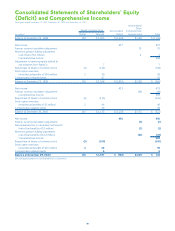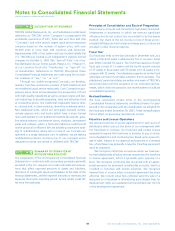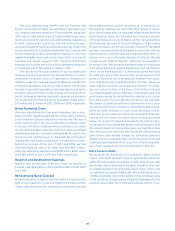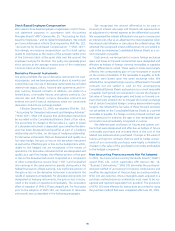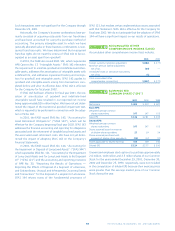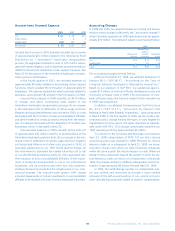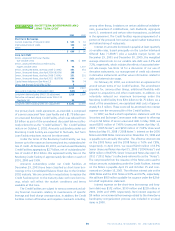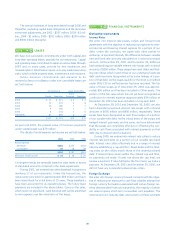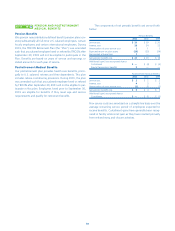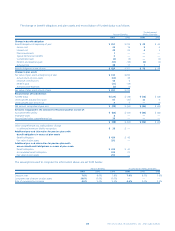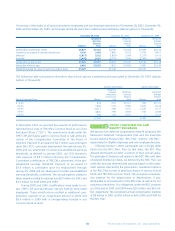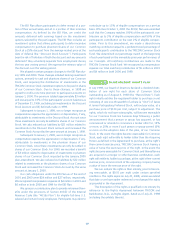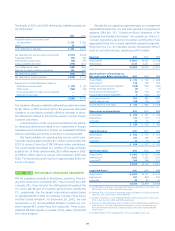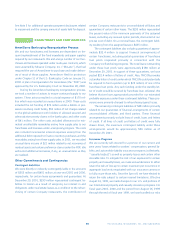Pizza Hut 2001 Annual Report Download - page 53
Download and view the complete annual report
Please find page 53 of the 2001 Pizza Hut annual report below. You can navigate through the pages in the report by either clicking on the pages listed below, or by using the keyword search tool below to find specific information within the annual report.
51
The annual maturities of long-term debt through 2006 and
thereafter, excluding capital lease obligations and the derivative
instrument adjustments, are 2002 – $537 million; 2003 – $1 mil-
lion; 2004 – $1 million; 2005 – $351 million; 2006 – $200 million
and $900 million thereafter.
LEASES
We have non-cancelable commitments under both capital and
long-term operating leases, primarily for our restaurants. Capital
and operating lease commitments expire at various dates through
2087 and, in many cases, provide for rent escalations and
renewal options. Most leases require us to pay related executory
costs, which include property taxes, maintenance and insurance.
Future minimum commitments and amounts to be
received as lessor or sublessor under non-cancelable leases are
set forth below:
Commitments Lease Receivables
Direct
Capital Operating Financing Operating
2002 $ 11 $ 221 $ 2 $ 9
2003 12 203 2 8
2004 10 180 1 7
2005 9 160 1 7
2006 8 134 1 6
Thereafter 87 893 8 33
$137 $1,791 $15 $ 70
At year-end 2001, the present value of minimum payments
under capital leases was $79 million.
The details of rental expense and income are set forth below:
2001 2000 1999
Rental expense
Minimum $ 283 $ 253 $ 263
Contingent 10 28 28
$ 293 $ 281 $ 291
Minimum rental income $14 $18 $20
Contingent rentals are generally based on sales levels in excess
of stipulated amounts contained in the lease agreements.
During 2001, we entered into sales-leaseback transactions
involving 17 of our restaurants. Under the transactions, the
restaurants were sold for approximately $18 million and have
been leased back for initial terms of 15 years. These leasebacks
have been accounted for as operating leases. The future lease
payments are included in the above tables. Gains on the sales,
which were not significant, were deferred and will be amortized
to rent expense over the initial term of the leases.
13
NOTE
FINANCIAL INSTRUMENTS
Derivative Instruments
Interest Rates
We enter into interest rate swaps, collars and forward rate
agreements with the objective of reducing our exposure to inter-
est rate risk and lowering interest expense for a portion of our
debt. Under the contracts, we agree with other parties to
exchange, at specified intervals, the difference between variable
rate and fixed rate amounts calculated on a notional principal
amount. At December 29, 2001 and December 30, 2000 we
had outstanding pay-variable interest rate swaps with notional
amounts of $350 million. These swaps have reset dates and float-
ing rate indices which match those of our underlying fixed-rate
debt and have been designated as fair value hedges of a por-
tion of that debt. As the swaps qualify for the short-cut method
under SFAS 133 no ineffectiveness has been recorded. The fair
value of these swaps as of December 29, 2001 was approxi-
mately $36 million and has been included in Other assets. The
portion of this fair value which has not yet been recognized as
a reduction to interest expense (approximately $34 million at
December 29, 2001) has been included in Long-term debt.
At December 29, 2001 and December 30, 2000, we also
had outstanding pay-fixed interest rate swaps with notional
amounts of $650 million and $450 million, respectively. These
swaps have been designated as cash flow hedges of a portion
of our variable-rate debt. As the critical terms of the swaps and
hedged interest payments are the same, we have determined
that the swaps are completely effective in offsetting the vari-
ability in cash flows associated with interest payments on that
debt due to interest rate fluctuations.
During 2000, we entered into interest rate collars to reduce
interest rate sensitivity on a portion of our variable rate bank
debt. Interest rate collars effectively lock in a range of interest
rates by establishing a cap and floor. Reset dates and the float-
ing index on the collars match those of the underlying bank
debt. If interest rates remain within the collared cap and floor,
no payments are made. If rates rise above the cap level, we
receive a payment. If rates fall below the floor level, we make a
payment. At December 29, 2001 and December 30, 2000, we
did not have any outstanding interest rate collars.
Foreign Exchange
We enter into foreign currency forward contracts with the objec-
tive of reducing our exposure to cash flow volatility arising from
foreign currency fluctuations associated with certain foreign cur-
rency denominated financial instruments, the majority of which
are intercompany short-term receivables and payables. The
notional amount, maturity date, and currency of these contracts
14
NOTE


